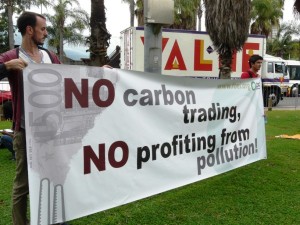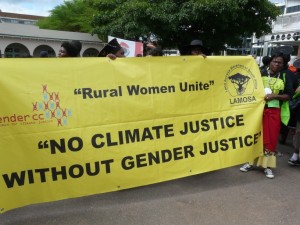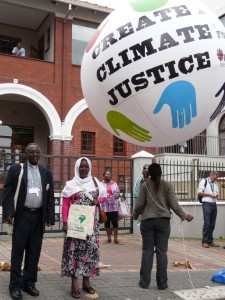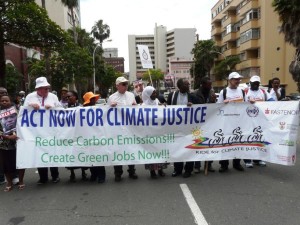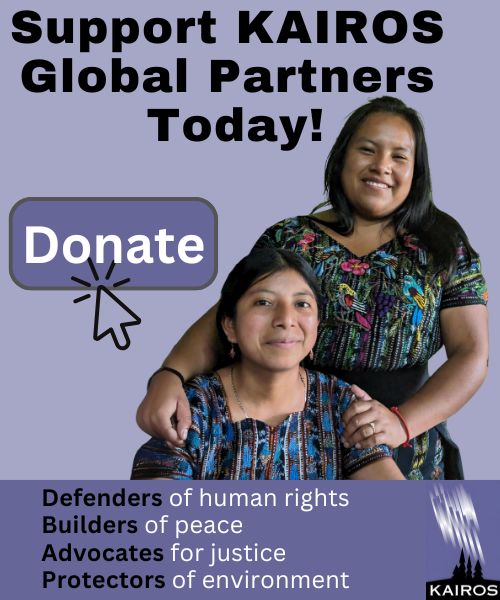Some final reflections
It’s the end of the second week of negotiations here in Durban. A fair number of official and civil society delegates have already returned home, as this is where political leaders are left to make final compromises. A total of some 14,570 people were accredited at the beginning of the COP. This doesn’t count those at the People’s Space at the University of KwaZulu-Natal’s Howard College campus who were not accredited. I wonder what the CO2 equivalent carbon footprint would be, comparatively, of all the participants’ travel and accommodation, the mountains of paper produced (even with recycling), the security and local support staff and volunteers, and utility bills.
There is pessimism about a second commitment period for Kyoto. China, Brazil and South Africa have demonstrated flexibility in countenancing legally binding emissions reductions beginning in 2020 under a new post-Kyoto agreement, though India has not (yet). The US (an observer), Japan and Russia are not yet willing to sign on to a second five or eight year second Kyoto commitment period. And Canada? Well, Canada now says a new agreement should be negotiated by 2015 to include all major emitters including the US, China and India and that this COP can lead toward that. Were that to happen, there would be a gap from 2013 on to whenever the next agreement would come into force.
Some here say the talks lack urgency and that the EU is consumed by its euro zone crisis summit in Brussels. The US, China, India and Brazil, responsible for roughly have of the world’s emissions, are key but deadlocked. They don’t want to start negotiations on a new treaty until after the next IPCC assessment report in 2013-2014. If negotiations don’t start until 2020, when emissions were to have peaked, as the US is pushing for, what hope would there be of keeping temperature rise to 2 degrees? Who will stand up and say they killed Kyoto?
Canada’s profile has been very low and guarded here in Durban. Six Canadian youth who stood up during Minister Kent’s speech in plenary and turned their backs on him were thrown out of the conference. When registering at the COP17 Civil Society’s People’s Space at the university, the from on the back of the badge asked for, in addition to net of kin phone number, chronic medical condition. I was tempted to put down cynicism and satire. I’m inspired by the transforming power of climate justice actions such as the creative, hopeful act of 2,000 children forming the image of a roaring lion in Durban’s beach to send a message to the negotiators. But I’m also reminded of the conspicuous COP17 sign at the Durban airport that reads “Saving Tomorrow Today” and can’t help but reframe it as “Saving Today’s Decisions for Tomorrow.”
As the world’s biggest emitter in absolute terms, surpassing the US, China has nevertheless shown its willingness to cut emissions in a legally binding agreement beginning in 2020. Canada’s approach seems to be that we’re not going to the right thing until everybody else does so first. Mimicking the US, Canada’s preoccupation with China being legally required to cut its greenhouse gas emissions as a condition for Canada to consider being part of a new agreement fails to appreciate China’s status as a developing economy. A column by Martin Khor (Third World Network, published in The Star, November 21st) was left laying around at one of the booths in the COP exhibition hall. Khor points out that by any yardstick, with 1.3 billion people, China is a developing country when looking at its per capita indicators. GDP per capita in 2010 ranked a lowly 91st of 184 countries at US$4,382, less than a tenth of the US. China’s GDP in terms of gross purchasing power made it 95th in the world, just below Ecuador. China ranks 101st out of 187 countries on the UNDP’s Human Development Index. It ranked 84th in the world in terms of emissions per person. As a middle income developing country, if China is pressured to take on the binding emission reductions of an historically industrial country it will forego the status and benefits of a developing country, and there are many more developed per capita countries ahead of it that would be pressured to do the same. One of the Fossil of Day awards earned by Canada here at COP17 was Minister Kent’s comment about “guilt payments” being asked of Canada, demonstrating a lack of understanding of the “common but differentiated responsibilities” embodied in the negotiations.
Following the interfaith service last Sunday, the Faith Secretariat held a coordination meeting. During part of the meeting we broke into three groups to strategize: mitigation, adaptation, and campaigns/communications. In the mitigation group as we were wrapping up to report back to plenary, Isaiah Toroitich (who had been in Canada in 2010 for KAIROS’ G20 Climate Justice Tour, formerly with Norwegian Church Aid, but now with ACT Alliance in Geneva) left hanging in the air something to the effect: “No deal may be better than a bad deal.” A bad deal would be if the eventual US$100 billion annual Green Climate Fund management were to be managed by the World Bank which has shown itself to be consumed with the carbon markets that almost preclude real carbon emission reductions. As for a second Kyoto Protocol commitment period at the end of 2012, as weak as it is – accounting for only a fraction of the carbon emissions that need to be cut – it is the best we have so far. Indeed, Nicola Bullard of Focus on the Global South states in Bond’s Politics of Climate Justice, “It is crucial to retain rich counties’ legally binding commitment to any future agreement and any alternative that could emerge at this stage would be much worse.”
COP17 has given me an opportunity to interact with a wide variety of people and hear many things. I me a nomadic Touareg from northern Niger based in Agadez with a group called Indigenous People of Africa. We spoke about the issues in Libya and how NATO was quick to exercise the Responsibility to Protect when oil was involved, but not in places like Darfur in western Sudan. The oil of new regime will only too willingly comply with the dictates of the West. I met a British educated Russian journalist in Murmansk (on the Barents Sea and largest city in world above the Arctic Circle) who said local residents there were largely happy with the effects of global warming. Julia and I participated in a worship service last Sunday at Durban’s Central Methodist Mission. The service was in Xhosa, South Africa’s second most popular language after Zulu spoken at home. After about an hour and a half of hearty singing we had to leave to get to the Diakonia Centre for our lunch rendezvous. While awaiting the start of the daily Climate Justice Now! debrief I could hear a presenter at a side event on the other side of a curtain saying the negotiated text in a certain document had many references to “whenever, wherever and whereas.” Such is nature, one supposes, of COP negotiations.
While there is paralysis above in terms of needful negotiations on climate change, there is movement below. The civil society resistance and alternative voice may not have been as forceful at COP17 as in Cancun, but there are signs that long-needed change will come. There are hopeful possibilities that the climate justice movement’s ability to mobilize, resist and transform may coalesce with the “occupy” movement, bringing along the blue-green (perhaps red-green outside North America) alliances, coupled with localized resistance to fossil and nuclear in favor of locally controlled renewable energy. The impetus of the Cochabamba conference of Indigenous people and civil society and renewed efforts of faith communities gives reason for hope that global citizens can take back the night of despair in what we’ve done to the Garden of Eden, our Mother Earth.

